Collection of materials relating to neuro-ophthalmology as part of the Neuro-Ophthalmology Virtual Education Library.
NOVEL: https://novel.utah.edu/
TO
- NOVEL966
Filters: Collection: "ehsl_novel_novel"
| Title | Creator | Description | Subject | ||
|---|---|---|---|---|---|
| 276 |
 |
Midbrain Hemorrhage | Shirley H. Wray, MD, PhD, FRCP | The patient is a 49 year old woman who was in good health until January 17, 1991. When, at work one morning, she had an acute attack of light headedness and double vision and collapsed on the floor without loss of consciousness. She developed a severe retro-orbital headache. She was taken to the loc... | Supranuclear Paralysis of Upgaze Hemorrhage; Convergence Retraction Nystagmus; Vertical Oculocephalic Reflex Normal; Normal Convergence; Skew Deviation; Light/Near Dissociation of the Pupils; Pretectal Syndrome; Midbrain Hemorrhage; Cavernous Angioma |
| 277 |
 |
Mitochondrial Myopathy (Guest Lecture) | Shirley H. Wray, MD, PhD, FRCP | See also: http://content.lib.utah.edu/cdm/ref/collection/ehsl-shw/id/120, http://content.lib.utah.edu/cdm/ref/collection/ehsl-shw/id/121, http://content.lib.utah.edu/cdm/ref/collection/ehsl-shw/id/124, http://content.lib.utah.edu/cdm/ref/collection/ehsl-shw/id/13, and http://content.lib.utah.edu/cdm... | Unilateral Ptosis; External Ophthalmoplegia Affecting Upgaze; Normal Pupils; Progressive External Ophthalmoplegia (PEO); Mitochondrial Myopathy; Unilateral Progressive External Ophthalmoplegia; Bilateral Ptosis; Facial Weakness; Complete External Ophthalmoplegia; Bilateral Progressive Exter... |
| 278 |
 |
Miller Fisher Syndrome: Guest Lecture | Shirley H. Wray, MD, PhD, FRCP | See also: http://content.lib.utah.edu/cdm/ref/collection/ehsl-shw/id/119, http://content.lib.utah.edu/cdm/ref/collection/ehsl-shw/id/29, and http://content.lib.utah.edu/cdm/ref/collection/ehsl-shw/id/37 | Voluntary Ptosis; Bilateral Sixth Nerve Palsy; Esotropia; Paresis of Conjugate Upgaze; Acute Inflammatory Demyelinating Neuropathy; Guillian Barre Syndrome - Miller Fisher Syndrome; Bilateral Ptosis; Total External Ophthalmoplegia; Facial Diplegia; Areflexia; Acute Inflammatory Demyelinati... |
| 279 |
 |
Multiple Sclerosis Lateropulsion | Shirley H. Wray, MD, PhD, FRCP | This 44 year old woman has a diagnosis of Multiple Sclerosis. See also: http://content.lib.utah.edu/cdm/ref/collection/ehsl-shw/id/281 | Deviation of the Eyes Under Closed Lids; Lateropulsion; Multiple Sclerosis |
| 280 |
 |
Paraneoplastic Opsocolonus | Shirley H. Wray, MD, PhD, FRCP | This patient is the index case of the Anti-Ri antibody, published in Annals of Neurology in 1988 (4). The Anti-Ri antibody is recognized to be a paraneoplastic marker in patients with breast and gynecological malignancies (10). The history of this case is particularly important because she was initi... | Opsoclonus; Ocular Flutter; Oscillopsia; Saccadic Oscillations; Paraneoplastic Cerebellar Syndrome; Adenocarcinoma of the Breast; Anti-Ri Antibody; Paraneoplastic Opsoclonus; Paraneoplastic Ocular Flutter; Saccadomania |
| 281 |
 |
Paraneoplastic Ocular Flutter | Shirley H. Wray, MD, PhD, FRCP | The patient is a 58 year old woman with known hypertension. In 1994, two weeks prior to admission she had a dramatic change in behavior with insomnia, agitation and depression. This was accompanied by "ringing of hands and anxiety for no apparent reason". She became anorexic, lost 15 pounds in weigh... | Ocular Flutter; Oscillopsia; Trunkal Ataxia; Paraneoplastic Cerebellar Syndrome; Small Cell Carcinoma of the Lung; Paraneoplastic Ocular Flutter; Flutter |
| 282 |
 |
Parasellar Meningioma | Shirley H. Wray, MD, PhD, FRCP | This patient is a 58 year old woman from Peru who, in 1975, developed intermittent headaches and right retro-orbital eye pain. She was seen by several ophthalmologists in South America who were unable to make a diagnosis. In March 1977 she awoke one morning with vertical diplopia most marked on look... | Ptosis; Third Nerve Palsy; Aberrant Reinnervation of the Third Nerve; Oculomotor Nerve; Parasellar Meningioma; Cavernous Sinus Syndrome; Unilateral Oculomotor Third Nerve Palsy; Unilateral Third Nerve Palsy |
| 283 |
 |
Parkinsons Disease | Shirley H. Wray, MD, PhD, FRCP | See also: http://content.lib.utah.edu/cdm/ref/collection/ehsl-shw/id/298 and http://content.lib.utah.edu/cdm/ref/collection/ehsl-shw/id/93 | Blepharoclonus; Convergence Insufficiency; Slow Hypometric Horizontal Saccades; Saccadic Breakdown of Smooth Pursuit; Parkinson's Disease- Dopamine deficiency; Basal Ganglia; Blepharoclonus; Convergence Insufficiency; Slow Hypometric Saccades; Saccadic Breakdown of Smooth Pursuit; Parkinson's Disea... |
| 284 |
 |
Neuroblastoma | Shirley H. Wray, MD, PhD, FRCP | The patient is Case 27-1995 Case Records of the Massachusetts General Hospital (New Eng. J Medicine 1995, 333:579-586). The discusser was Dr. Elizabeth Engle, Associate Professor of Neurology, Harvard Medical School. The baby girl was born after a 30 week gestation, with a birth weight of 1.25 kg. T... | Downbeat Nystagmus; Paraneoplastic Opsoclonus; Neuroblastoma; Primary Position Downbeat Nystagmus; Ataxia; Paraneoplastic Downbeat Nystagmus |
| 285 |
 |
Introduction to NANOS NOTE | Karl C. Golnik, MD | Introduction to NANOS NOTE, a resource for non-neuro-ophthalmologists describing common examination techniques. | Neuro-Ophthalmology Examination Techniques |
| 286 |
 |
Septo-Optic Dysplasia | Kathleen B. Digre, MD; James J. Corbett, MD | Slideshow describing the condition. | Septo-optic Dysplasia |
| 287 |
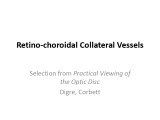 |
Retino-choroidal Collateral Vessels | Kathleen B. Digre, MD; James J. Corbett, MD | Slideshow describing condition. | Collateral Vessels |
| 288 |
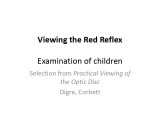 |
Viewing the Red Reflex | Kathleen B. Digre, MD; James J. Corbett, MD | Slideshow describing eye examination of children. | Eye Examination |
| 289 |
 |
Photophobia for Patients - Large Print | Kathleen B. Digre, MD | The symptoms of light sensitivity are: an uncomfortable sense of brightness, squinting, frequent blinking, and redness of the eye (especially if the eye is dry). Involuntary eye closure and excessive blinking is seen with blepharospasm. Individuals will tend to seclude themselves in darkness. | Photophobia |
| 290 |
 |
Papilledema 2013 | Kathleen B. Digre, MD | Objectives: What types of disc findings can be confused for papilledema List the features of true disc swelling Describe the tests you would order to evaluate and w/u papilledema List differential diagnosis of papilledema Describe possible treatments for papilledema (medical and surgical) | Papilledema |
| 291 |
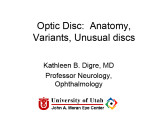 |
Optic Disc Anatomy, Variants, and Usual Discs | Kathleen B. Digre, MD | Examination of optic disc, disc anatomy, disc variation. | Optic Disc; Normal Disc Anatomy |
| 292 |
 |
Retinal Detachment: The Basics | Arnav Gupta, BHSc; Rahul Sharma, MD, MPH | A presentation describing retinal detachment. | Retinal Detachment |
| 293 |
 |
Retinal Exudate: The Basics | Arnav Gupta, BHSc; Rahul Sharma, MD, MPH | A presentation describing retinal exudate. | Retinal Exudate |
| 294 |
 |
Retinal Hemorrhage: The Basics | Arnav Gupta, BHSc; Rahul Sharma, MD, MPH | A presentation describing retinal hemorrhage. | Retinal Hemorrhage |
| 295 |
 |
Retinal Causes of a Neurologic-Type Visual Field Defect | Omar Ozgur, MD; Rudrani Banik, MD | Power point of case presentation of 47 year old female with history of breast cancer with new onset temporal visual field defect and photopsias. Differential diagnosis of homonymous hemianopia discussed; retinal causes of neurologic-type visual field defects reviewed including: white dot syndrome (m... | Homonymous Hemianopia; Neurologic Visual Field Defect; Temporal Visual Field Defect; White Dot Syndrome; Multiple Evanescent White Dot Syndrome (MEWDS); Cancer-Associated Retinopathy; Tamoxifen Retinopathy; Autoimmune Retinopathy |
| 296 |
 |
Patient Portal: Optic Disc Drusen | Cristiano Oliveira, MD | Optic disc drusen (ODD) are abnormal deposits of benign, usually calcified material within the optic disc, which is the front part of the optic nerve that connects each eye to the brain. We do not know the exact cause of optic disc drusen. They are present in 0.3-2% of people as an isolated case or ... | Optic disc drusen; Papilledema; Pseudopapilledema |
| 297 |
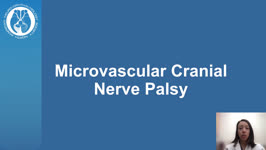 |
Patient Portal: Microvascular Cranial Nerve Palsy | Meagan Seay, DO | A nerve palsy is an impairment in the function of a nerve, which results in a decrease in function of the corresponding muscles controlled by that nerve. In microvascular cranial nerve palsy, something affects the blood supply to one of the cranial nerves, causing it not to work. This is usually the... | Nerve palsy; Microvascular cranial nerve palsy; Cranial nerve 3; CN3; Oculomotor nerve; Cranial nerve 4; CN4; Trochlear nerve; Cranial nerve 6; CN6; Abducens nerve |
| 298 |
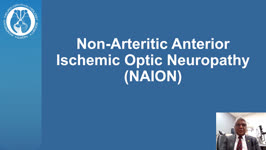 |
Patient Portal: Non-Arteritic-Anterior Ischemic Optic Neuropathy (NAION) | Arun Sundaram, MD | Non-arteritic anterior ischemic optic neuropathy (NAION or NA-AION) is caused by decreased blood flow to the front part of the optic nerve (optic disc). It causes optic nerve swelling and sudden vision loss. NAION typically affects one eye, although the other eye sometimes suffers similar loss month... | Non-arteritic anterior ischemic optic neuropathy; NAION; NA-AION; Optic nerve; Optic disc; Ophthalmic artery |
| 299 |
 |
Patient Portal: Myasthenia Gravis | Aroucha Vickers, DO | Myasthenia gravis (MG) is an autoimmune disease in which the body's immune system creates antibodies (proteins that normally protect us) that may attack receptors on your muscles. This results in muscle weakness because the muscles do not receive the signals to contract (tighten). Muscles anywhere w... | Myasthenia gravis; Ptosis; Double vision |
| 300 |
 |
Patient Portal: Giant Cell Arteritis | Anne S. Abel, MD | Giant cell arteritis is an inflammatory condition that can cause vision loss, double vision, fever, new persistent headaches, scalp tenderness, and jaw pain with chewing. GCA is caused by inflammation of blood vessels, primarily in the head and neck. Sometimes called "temporal arteritis," GCA frequ... | Giant cell arteritis |
